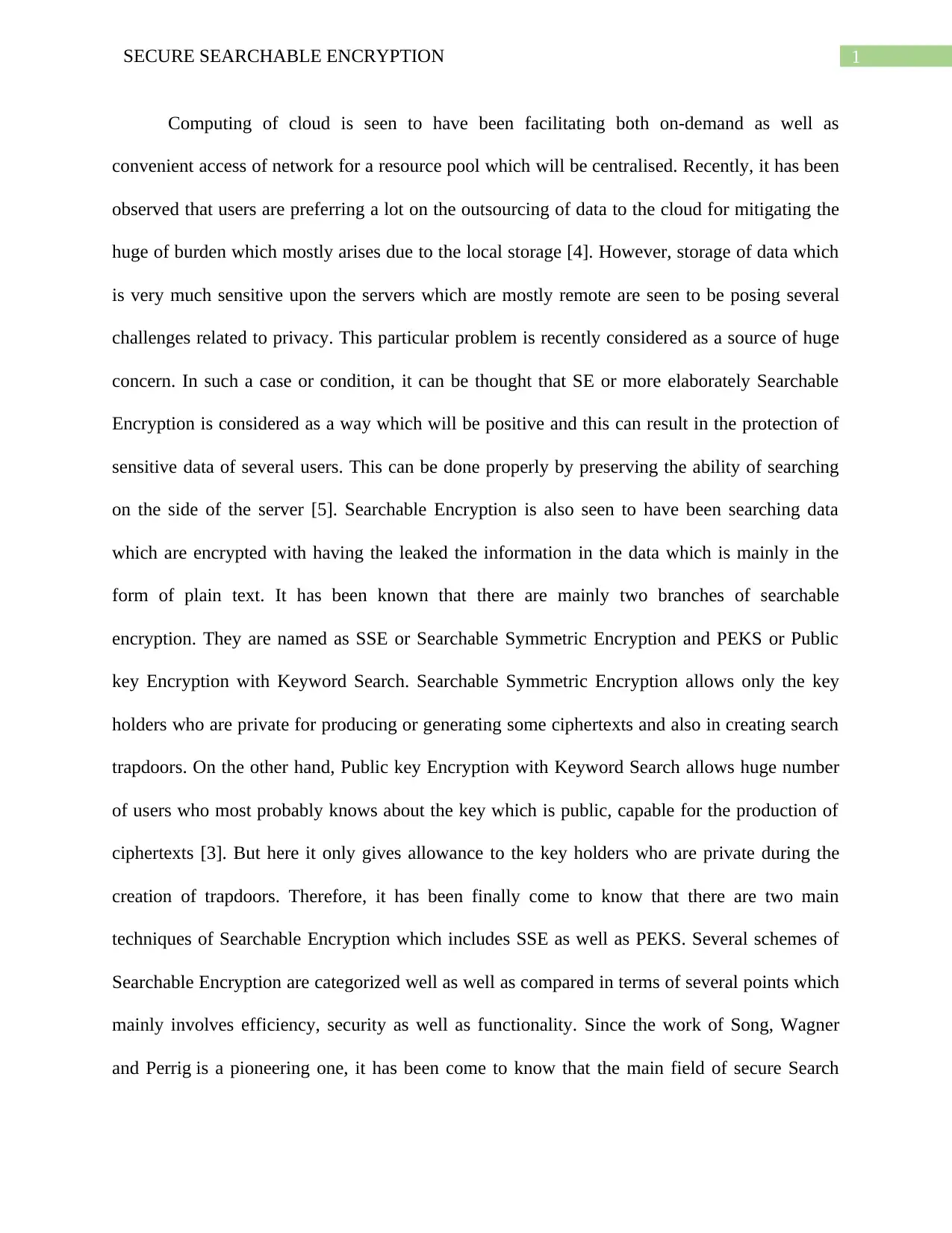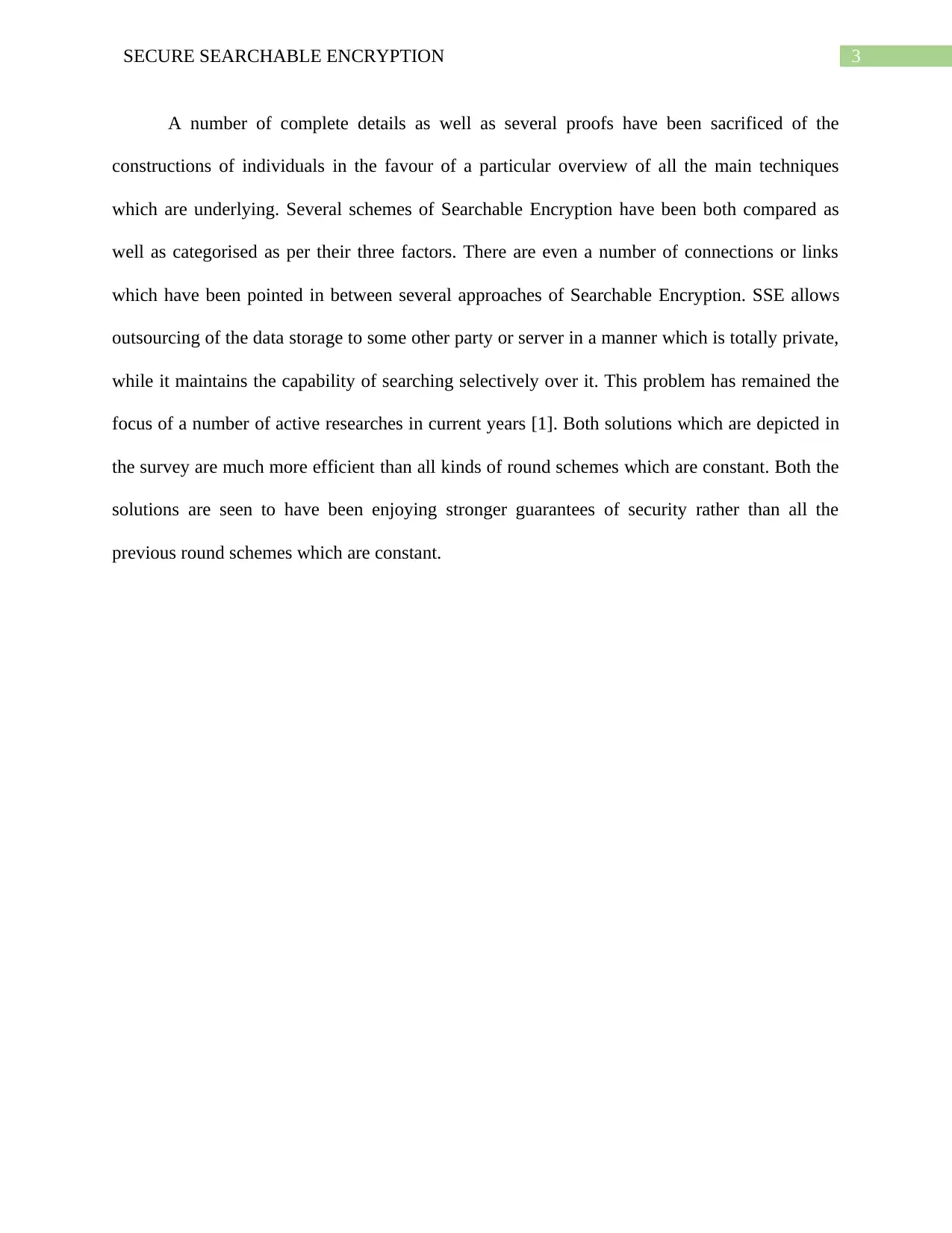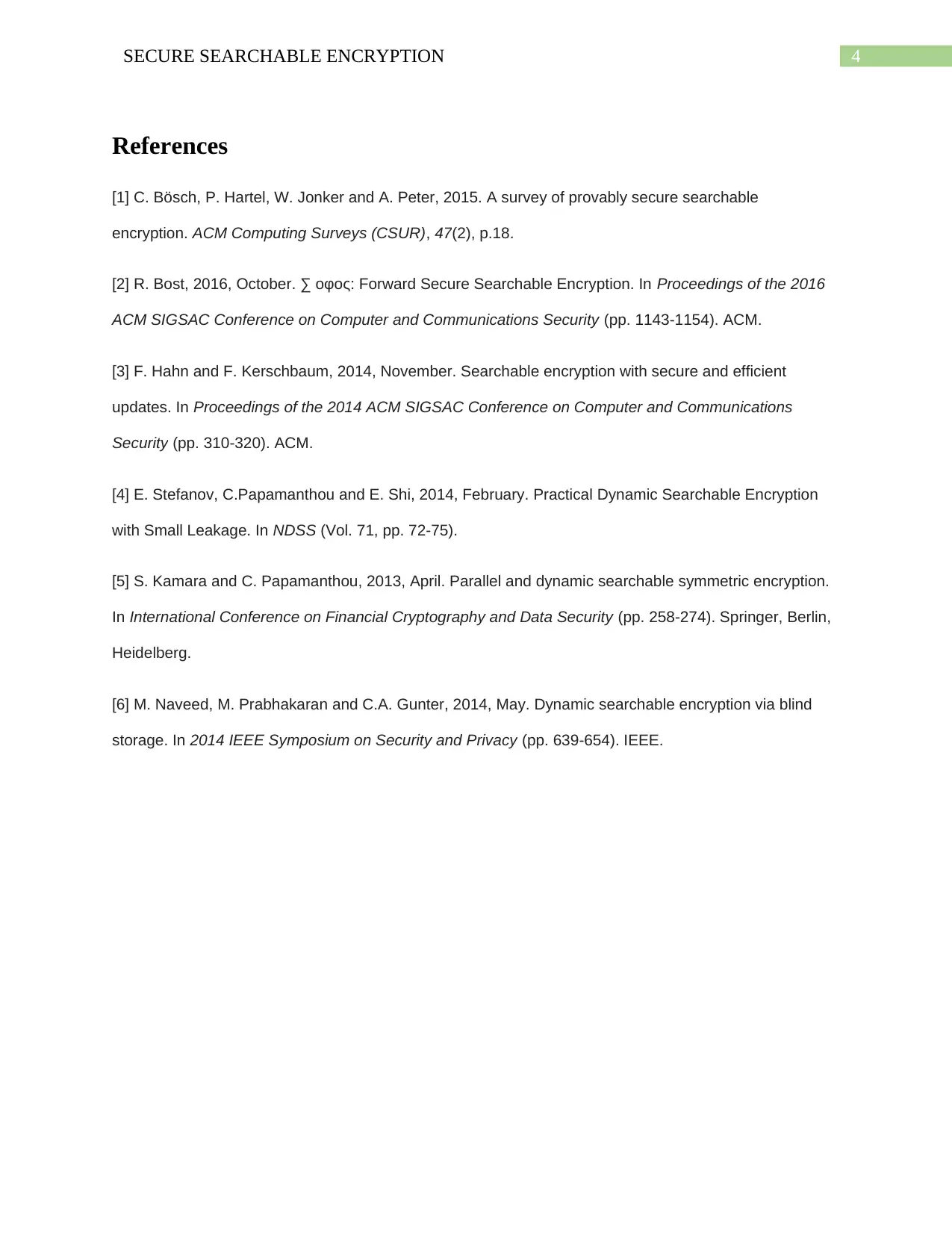A Detailed Analysis of Secure Searchable Encryption Techniques
VerifiedAdded on 2023/01/19
|5
|1158
|61
Report
AI Summary
This report provides a comprehensive overview of Secure Searchable Encryption (SE), a crucial technique for protecting sensitive data in cloud computing environments. It explores two primary branches: Searchable Symmetric Encryption (SSE) and Public key Encryption with Keyword Search (PEKS), ...

Running head: SECURE SEARCHABLE ENCRYPTION
SECURE SEARCHABLE ENCRYPTION
Name of the Student
Name of the Organization
Author Note
SECURE SEARCHABLE ENCRYPTION
Name of the Student
Name of the Organization
Author Note
Paraphrase This Document
Need a fresh take? Get an instant paraphrase of this document with our AI Paraphraser

1SECURE SEARCHABLE ENCRYPTION
Computing of cloud is seen to have been facilitating both on-demand as well as
convenient access of network for a resource pool which will be centralised. Recently, it has been
observed that users are preferring a lot on the outsourcing of data to the cloud for mitigating the
huge of burden which mostly arises due to the local storage [4]. However, storage of data which
is very much sensitive upon the servers which are mostly remote are seen to be posing several
challenges related to privacy. This particular problem is recently considered as a source of huge
concern. In such a case or condition, it can be thought that SE or more elaborately Searchable
Encryption is considered as a way which will be positive and this can result in the protection of
sensitive data of several users. This can be done properly by preserving the ability of searching
on the side of the server [5]. Searchable Encryption is also seen to have been searching data
which are encrypted with having the leaked the information in the data which is mainly in the
form of plain text. It has been known that there are mainly two branches of searchable
encryption. They are named as SSE or Searchable Symmetric Encryption and PEKS or Public
key Encryption with Keyword Search. Searchable Symmetric Encryption allows only the key
holders who are private for producing or generating some ciphertexts and also in creating search
trapdoors. On the other hand, Public key Encryption with Keyword Search allows huge number
of users who most probably knows about the key which is public, capable for the production of
ciphertexts [3]. But here it only gives allowance to the key holders who are private during the
creation of trapdoors. Therefore, it has been finally come to know that there are two main
techniques of Searchable Encryption which includes SSE as well as PEKS. Several schemes of
Searchable Encryption are categorized well as well as compared in terms of several points which
mainly involves efficiency, security as well as functionality. Since the work of Song, Wagner
and Perrig is a pioneering one, it has been come to know that the main field of secure Search
Computing of cloud is seen to have been facilitating both on-demand as well as
convenient access of network for a resource pool which will be centralised. Recently, it has been
observed that users are preferring a lot on the outsourcing of data to the cloud for mitigating the
huge of burden which mostly arises due to the local storage [4]. However, storage of data which
is very much sensitive upon the servers which are mostly remote are seen to be posing several
challenges related to privacy. This particular problem is recently considered as a source of huge
concern. In such a case or condition, it can be thought that SE or more elaborately Searchable
Encryption is considered as a way which will be positive and this can result in the protection of
sensitive data of several users. This can be done properly by preserving the ability of searching
on the side of the server [5]. Searchable Encryption is also seen to have been searching data
which are encrypted with having the leaked the information in the data which is mainly in the
form of plain text. It has been known that there are mainly two branches of searchable
encryption. They are named as SSE or Searchable Symmetric Encryption and PEKS or Public
key Encryption with Keyword Search. Searchable Symmetric Encryption allows only the key
holders who are private for producing or generating some ciphertexts and also in creating search
trapdoors. On the other hand, Public key Encryption with Keyword Search allows huge number
of users who most probably knows about the key which is public, capable for the production of
ciphertexts [3]. But here it only gives allowance to the key holders who are private during the
creation of trapdoors. Therefore, it has been finally come to know that there are two main
techniques of Searchable Encryption which includes SSE as well as PEKS. Several schemes of
Searchable Encryption are categorized well as well as compared in terms of several points which
mainly involves efficiency, security as well as functionality. Since the work of Song, Wagner
and Perrig is a pioneering one, it has been come to know that the main field of secure Search

2SECURE SEARCHABLE ENCRYPTION
Encryption has been expanded to such a point that it has been felt that obtaining a stock may
provide a huge benefit to the whole community [6]. It has also been observed that the survey has
been clearly written for all the non-specialists primarily who possess only a certain basic
information about the security of the background.
Several conclusions are drawn from the survey upon the secure Searchable Encryption.
The main two of them are so called IND-CKA2 notion of security and the schemes of Searchable
Encryption which are efficient [2]. The IND-CKA2 notion of security is seen to have become
particularly prevalent as per the literature within the survey of SE. On the other hand, all the sub-
linear as well as efficient schemes of Searchable Encryption which is meeting this particular
notion is also to be existing in a setting which is symmetric and this will help a lot in maintaining
security. The achievement of such a strong form of maintaining security in a setting which is
totally asymmetric still remains a problem which is totally open. It has also been observed that in
all the schemes of Searchable Encryption which are based upon more than more than one or
rather multiple-recipient, regardless of any kinds of drawbacks or disadvantages in their
efficiency, there remains a lack of expressiveness of query which will help in hindering
deployment in practice.
It can be concluded that the simplicity of both the solutions is a very important step which
provides deployment of the technologies of SSE. All the multi user SSE are also to be
considered. SSE has been finally defined as a setting based upon multi-user and has been able to
present a construction which is very much efficient in achieving better performance rather than
simply utilising several mechanisms of the control of access.
Encryption has been expanded to such a point that it has been felt that obtaining a stock may
provide a huge benefit to the whole community [6]. It has also been observed that the survey has
been clearly written for all the non-specialists primarily who possess only a certain basic
information about the security of the background.
Several conclusions are drawn from the survey upon the secure Searchable Encryption.
The main two of them are so called IND-CKA2 notion of security and the schemes of Searchable
Encryption which are efficient [2]. The IND-CKA2 notion of security is seen to have become
particularly prevalent as per the literature within the survey of SE. On the other hand, all the sub-
linear as well as efficient schemes of Searchable Encryption which is meeting this particular
notion is also to be existing in a setting which is symmetric and this will help a lot in maintaining
security. The achievement of such a strong form of maintaining security in a setting which is
totally asymmetric still remains a problem which is totally open. It has also been observed that in
all the schemes of Searchable Encryption which are based upon more than more than one or
rather multiple-recipient, regardless of any kinds of drawbacks or disadvantages in their
efficiency, there remains a lack of expressiveness of query which will help in hindering
deployment in practice.
It can be concluded that the simplicity of both the solutions is a very important step which
provides deployment of the technologies of SSE. All the multi user SSE are also to be
considered. SSE has been finally defined as a setting based upon multi-user and has been able to
present a construction which is very much efficient in achieving better performance rather than
simply utilising several mechanisms of the control of access.
⊘ This is a preview!⊘
Do you want full access?
Subscribe today to unlock all pages.

Trusted by 1+ million students worldwide

3SECURE SEARCHABLE ENCRYPTION
A number of complete details as well as several proofs have been sacrificed of the
constructions of individuals in the favour of a particular overview of all the main techniques
which are underlying. Several schemes of Searchable Encryption have been both compared as
well as categorised as per their three factors. There are even a number of connections or links
which have been pointed in between several approaches of Searchable Encryption. SSE allows
outsourcing of the data storage to some other party or server in a manner which is totally private,
while it maintains the capability of searching selectively over it. This problem has remained the
focus of a number of active researches in current years [1]. Both solutions which are depicted in
the survey are much more efficient than all kinds of round schemes which are constant. Both the
solutions are seen to have been enjoying stronger guarantees of security rather than all the
previous round schemes which are constant.
A number of complete details as well as several proofs have been sacrificed of the
constructions of individuals in the favour of a particular overview of all the main techniques
which are underlying. Several schemes of Searchable Encryption have been both compared as
well as categorised as per their three factors. There are even a number of connections or links
which have been pointed in between several approaches of Searchable Encryption. SSE allows
outsourcing of the data storage to some other party or server in a manner which is totally private,
while it maintains the capability of searching selectively over it. This problem has remained the
focus of a number of active researches in current years [1]. Both solutions which are depicted in
the survey are much more efficient than all kinds of round schemes which are constant. Both the
solutions are seen to have been enjoying stronger guarantees of security rather than all the
previous round schemes which are constant.
Paraphrase This Document
Need a fresh take? Get an instant paraphrase of this document with our AI Paraphraser

4SECURE SEARCHABLE ENCRYPTION
References
[1] C. Bösch, P. Hartel, W. Jonker and A. Peter, 2015. A survey of provably secure searchable
encryption. ACM Computing Surveys (CSUR), 47(2), p.18.
[2] R. Bost, 2016, October. ∑ oφoς: Forward Secure Searchable Encryption. In Proceedings of the 2016
ACM SIGSAC Conference on Computer and Communications Security (pp. 1143-1154). ACM.
[3] F. Hahn and F. Kerschbaum, 2014, November. Searchable encryption with secure and efficient
updates. In Proceedings of the 2014 ACM SIGSAC Conference on Computer and Communications
Security (pp. 310-320). ACM.
[4] E. Stefanov, C.Papamanthou and E. Shi, 2014, February. Practical Dynamic Searchable Encryption
with Small Leakage. In NDSS (Vol. 71, pp. 72-75).
[5] S. Kamara and C. Papamanthou, 2013, April. Parallel and dynamic searchable symmetric encryption.
In International Conference on Financial Cryptography and Data Security (pp. 258-274). Springer, Berlin,
Heidelberg.
[6] M. Naveed, M. Prabhakaran and C.A. Gunter, 2014, May. Dynamic searchable encryption via blind
storage. In 2014 IEEE Symposium on Security and Privacy (pp. 639-654). IEEE.
References
[1] C. Bösch, P. Hartel, W. Jonker and A. Peter, 2015. A survey of provably secure searchable
encryption. ACM Computing Surveys (CSUR), 47(2), p.18.
[2] R. Bost, 2016, October. ∑ oφoς: Forward Secure Searchable Encryption. In Proceedings of the 2016
ACM SIGSAC Conference on Computer and Communications Security (pp. 1143-1154). ACM.
[3] F. Hahn and F. Kerschbaum, 2014, November. Searchable encryption with secure and efficient
updates. In Proceedings of the 2014 ACM SIGSAC Conference on Computer and Communications
Security (pp. 310-320). ACM.
[4] E. Stefanov, C.Papamanthou and E. Shi, 2014, February. Practical Dynamic Searchable Encryption
with Small Leakage. In NDSS (Vol. 71, pp. 72-75).
[5] S. Kamara and C. Papamanthou, 2013, April. Parallel and dynamic searchable symmetric encryption.
In International Conference on Financial Cryptography and Data Security (pp. 258-274). Springer, Berlin,
Heidelberg.
[6] M. Naveed, M. Prabhakaran and C.A. Gunter, 2014, May. Dynamic searchable encryption via blind
storage. In 2014 IEEE Symposium on Security and Privacy (pp. 639-654). IEEE.
1 out of 5
Related Documents
Your All-in-One AI-Powered Toolkit for Academic Success.
+13062052269
info@desklib.com
Available 24*7 on WhatsApp / Email
![[object Object]](/_next/static/media/star-bottom.7253800d.svg)
Unlock your academic potential
© 2024 | Zucol Services PVT LTD | All rights reserved.




